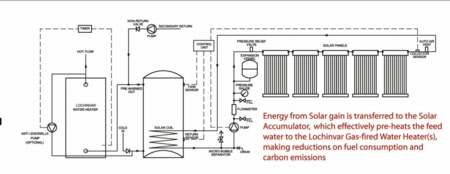Combining gas with renewable energy

Condensing technology is used extensively in direct gas-fired water heaters. Shown here is a Lochinvar Eco Knight and two sizes of Turbo Charger.
• Boiler with indirect cylinder, 80%. The trend towards condensing boilers has given further justification towards the separation of space heating and domestic hot water, and the use of DFWHs allows the condensing boiler to provide for the heating system only, enabling them to operate at best efficiency. The 7% difference in the minimum levels of efficiency takes into account the heat transfer loss from the boiler primary pipework to the cylinder, although these losses can be significantly higher in some situations. Accurate sizing of a water heater system is of paramount importance, not only in the drive towards conserving fuel resources, but also in providing a reliable supply of hot water when required. Traditional indirect systems were usually sized by providing sufficient storage capacity to meet peak demand. A drawback here is that large volumes of water are maintained at high temperatures during long periods of the day when there may be little or no demand. Instantaneous water heaters overcome this problem and have been extensively used in households for many years. The demands for hot water in most commercial and industrial buildings can be met by DFWHs which operate on the principles of low-storage but fast recovery of hot water. Typically, such products can have an output which allows for quick water heat-up, so the storage can be recovered in short periods of time (10 minutes to 1 h). This offers significant benefits to many establishments with a peak demand for hot water. Hotels, leisure centres, factories and commercial kitchens are amongst these properties where this occurs. Most DFWH manufacturers offer assistance on selecting water Heaters, either via sizing software or hard copy guides, but every application may have variations that should be considered, and the combination of storage and recovery is an important factor. The role of renewable technologies, particularly solar thermal is forefront in the mind of many building-services consultants when considering hot-water generation for a building. Combining DFWHs with solar installations is growing in popularity, and the evolving use of solar for hot-water generation in the UK lends itself ideally to a system based on using solar energy to pre-heat the feed water for a DFWH. A twin-coiled cylinder enables solar energy to be used with traditional boiler/indirect hot water generation, but this arrangement is generally regarded as being less efficient than the pre-heat alternative. Sizing of the pre-heat cylinder is extremely important, and a larger capacity will provide the opportunity to make the most of solar gain.
 |
Solar thermal panels can work well with direct gas-fired water heaters by pre-heating the cold feed water. |








